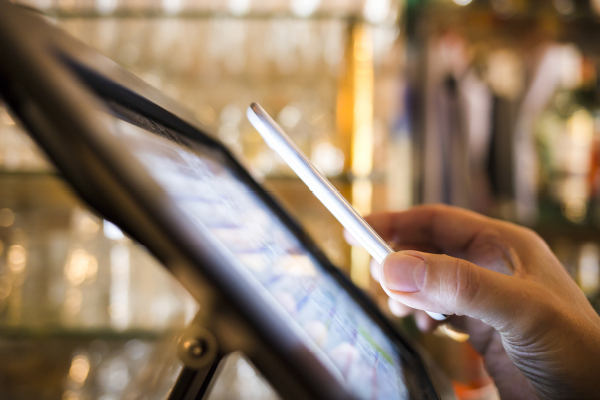From the moment that mobile phones became as common as carrying a wallet, advancements in their abilities and technologies have continued to shape the way we live our lives. Near Field Communication is next in this line of paradigm shifting technologies. 
The addition of a digital camera to our phones spawned an unprecedented onslaught of pictures and video captured and recorded. Shortly after, our phones became smart, and the power of the Internet and social networking was suddenly in the palm of our hands. Sites like Twitter and Facebook boomed, new companies like Instagram came into existence and the very concept of a mobile device changed from a phone with features to one of the primary nodes in which people connected to the Internet and world around them.
Near Field Communication is set to become the next one in this line of innovative, paradigm shifting technologies. It is becoming increasingly common to simply hover a card or a device near a payment portal, and be on our way. NFC can be found in everything from concert tickets, to metrocards, to purchases using our mobile phones. As the technology takes hold, we are fast moving away from traditional methods of checking in and topping up.
Surprisingly, the next wave of technological innovation stems from something as old and seemingly out of date as radio waves. To help us understand more about how NFC actually works, Jawad Shaikh, Executive Vice President, Digital Business, du, weighs in on the new wave of mobile technology.
“Most people will know Near Field Communication as a convenient ‘tap and pay’ experience,” he says. “NFC enables short range communication between compatible devices using radio waves. NFC requires at least one transmitting device and another to receive the signal.”
To those in the know, this may sound a bit like an existing technology that has been in place for quite some time. “It’s important not to confuse NFC with RFID,” Shaikh points out, “NFC has evolved from RFID technology, however there are key differences. RFID is the method of uniquely identifying items using radio waves. NFC is simply a subset of RFID which offers close proximity communication.
Another major difference between NFC and RFID is the range. RFID can reach for miles, while NFC is purposefully limited to a range of approximately four inches. RFID technology usually works well over a few metres and is a one-way communication platform. “NFC technology usually works at a maximum range of about 10 centimetres and can be set up for two-way communications as well,” explains Shams Hasan, Regional Enterprise Product Manager, Dell.
In this respect, NFC is ideal for transactions that require a greater level of security, like payment transactions. NFC is also a two way signal, as opposed to a one way transmission with RFID. With NFC, the chips within the device – whether it’s something as simple as a metrocard, or as complex as a mobile phone – communicate small amounts of data back and forth between the two NFC chips which are activated by proximity to each other. Because it uses radio frequencies, NFC requires much less power than other wireless technologies.
“Smartphones are by far the most common implementation of NFC devices,” explains Shaikh. “But the technology is being seen commonly in many other places such as public transport card readers and touch payment terminals.”
Many companies are taking advantage of this new and exciting technology, specifically mobile service providers.
Emirates NBD is a local innovator in this space having successfully pioneered a number of initiatives in contactless and mobile payments. Bank Audi has also recently announced a partnership with MasterCard to release the new “Tap2Pay” solution. “With NFC we need to provide services that encourage the user to switch from plastic to phone and that will not happen purely from payments,” says Julian Phillips, Vice President Acceptance & Commercial Development UAE, MasterCard. “There needs to be other services available as well, so one of the key drivers for MasterCard is to identify such services and bring them to market via our various partners.”
One of the most exciting aspects of NFC is the ability to digitise wallets, and make paying for everything from a cup of coffee to a plane ticket more streamlined and efficient. The technology that was originally only in cards is now moving to mobile devices, making payment for smartphone users ever more convenient. Shaikh explains, “To make a transaction, the consumer simply brings their smartphone to within a few inches of a point of sale system that is capable of contactless payment.”
Of course, this is only a successful way to pay if the retailer is equipped with the proper technology to receive the payment. The POS node is the second part of this exchange and retailers must be willing to equip themselves with the NFC technology in order for these types of transactions to take place. In other words, it takes effort from both sides, and even though the NFC technology involved on both ends is relatively simple, retailers and consumers alike must actively participate to make it a success.
Shaikh acknowledges the need to build the network so that NFC technology reaches its potential as the new standard for financial and other transactions. “We need a multiple stakeholder ecosystem for these types of payments to become more commonplace,” he says, adding, “Our Beam Wallet partnership is a good example, bringing together a network of consumers, retailers and a proven mobile wallet solution.”
The main concern regarding these financial transactions is security. Speed and convenience are only worthwhile if the data being exchanged is safe and secure. To that end NFC technology – at least in the case of mobile devices – offers two levels of security solutions.
“Personal information, including financial information, is stored in a secured area in the NFC SIM – similar to a chip on a banking card,” explains Shaikh. “This hardware security is coupled with software-based security for apps running NFC services, which includes hosting the infrastructure in highly secure data centres. This secures your information if your phone is stolen.”
The speed of information has continued to increase exponentially as our technology evolves to become faster, smaller, smarter and more integrated with our lives. Innovations continue to find new ways to streamline daily interactions, make life more convenient, more productive, and ideally more secure. Like the advancements before it that continue to shape our lives in a multitude of ways, NFC promises to change the way we interact with our money, our devices, and indeed our world.





